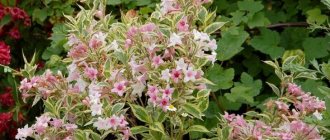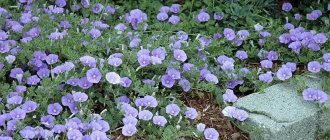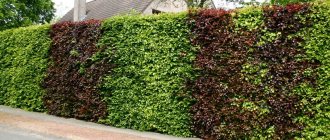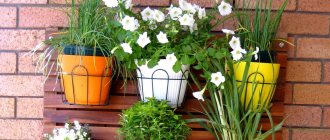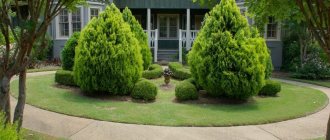Garden ivy
It climbs easily and is fixed to supports and walls, therefore it is widely used in creating landscape compositions. It can grow up to 30 meters in length, entwining buildings with aerial sucker roots.
It loves warmth, so it is mainly found in regions with mild climates, but some frost-resistant varieties are successfully grown in the middle zone and feel good in shaded places without wind and stagnant groundwater.
The photo shows ivy, which is actively used in vertical gardening, planted near the walls of buildings, pergolas and gazebos. It creates useful shade and makes the area more cozy.
Propagated by cuttings. Care includes proper watering, fertilizing with nitrogen-containing fertilizers, mulching with organic materials, loosening the soil, and sometimes pruning. In dry weather, watering is increased, and in rainy weather, it is reduced.
Thunbergia winged
Thunbergia winged
Thunbergia winged has such a funny appearance that it would be wrong not to mention it in our selection. Its flowers with a dark center (the color of dark chocolate with a purple tint) can have yellow, orange, white and apricot petals. Thunbergia alata can grow up to 2 meters in length and grows best in full sun.
Note: in regions where there is no frost, winged thunbergia grows as a perennial. New varieties have also been developed in which the center of the flower is not at all dark.
Wisteria
Luxurious wisteria is a climbing garden plant that takes root only in a subtropical climate, that is, in the south of Russia. A shrub with graceful trusses in which flowers are collected, reminiscent of grapes. The height of wisteria can reach 15 meters. The main condition for abundant flowering is sun.
The photo shows wisteria entwining a wooden pergola. If the plant grows along the wall, it can damage the structure of the building.
New varieties (for example, Wisteria macrostachia) can withstand temperatures down to -40°. Used for vertical decoration of pergolas, gazebos, fences and balconies, they require support. The lifespan of a shrub can be up to 150 years. Does not like abundant watering and requires spraying on hot days.
Sweet pea
Sweet peas
Note that, unfortunately, not all varieties of sweet peas emit a strong aroma, but they all bloom with beautiful flowers and the color palette of sweet peas is presented in almost every color - from white to almost black.
The vines can grow up to 2 meters in length. Sweet peas love sun, although partial shade will do just fine.
Note: In hot climates, sweet peas may scorch in an open, sunny spot, so it is best to plant sweet peas in a location that receives shade during the midday and hottest hours.
climbing roses
Despite its aesthetics and elegance of appearance, this perennial climbing plant is considered unpretentious and easy to care for. It is a tall bush that grows up to 15 meters, so the rose can be found in many summer cottages.
The photo shows roses of a rich shade entwining a fence made of slats. To stimulate the appearance of a large number of buds, we recommend tying the vines in a horizontal position.
Climbing plants perennials
Perennial vines can be used to cover chain-link fences and unsightly buildings. They are undemanding in care, frost-resistant, and have original foliage. To grow a beautiful plant, it is important to know agrotechnical rules and choose a variety that will suit the climatic conditions.
Actinidia
A perennial loach used to decorate house walls, gazebos and arches. The plant is not capricious, fast growing. When planting female and male plants, you can get a good harvest.
The loach prefers slightly acidic soil and a well-lit place. Growth requires abundant watering and timely fertilizing with organic matter and mineral fertilizers. The most winter-hardy varieties: Kolomikta, Arguta, Koloza, Polygama.
The fruits of the vine are small and taste like kiwi.
Ampelopsis
Decorative, perennial loach, clinging to support with tendrils or suckers. The plant has medium-sized leaves, shaped like a grape leaf, and berries of various colors.
For good growth and development, the loach is planted in partial shade. Care consists of timely watering, sanitary pruning and shelter for the winter.
Liana is suitable for landscaping arches, fences, gazebos
Dioscorea
A perennial loach intended for cultivation in regions with warm climates. Grows in a sunny place, on fertile soil.
Important! Liana is suitable for decorating external stairs, arches, and balconies.
Without shelter, the ground part freezes, but in the spring the plant quickly recovers and grows long vines.
Kirkazon
Decorative, perennial climber, intended for landscaping large horizontal surfaces. The liana is unpretentious, tolerates severe gas pollution and frost. Grows in shade and partial shade on depleted soil. Strong winds tear off the foliage, thereby losing the decorative effect of the vine. Frost-resistant species: Large-leaved, Manchurian, Ordinary, Graceful.
Read more Unpretentious perennial flowers for the cemetery: photos with names
The plant has one drawback - it does not tolerate drafts
Schisandra chinensis
An elegant, perennial loach, reaching a height of up to 15 m. The liana is fast-growing, the annual growth is about 3 m. It is attached to the support by shoots.
Important! Schisandra chinensis not only has a decorative appearance, but also has medicinal properties.
It is better to direct the growth of the vine along a wooden or plastic support, since there is a possibility of shoots freezing near the metal
Ivy
An evergreen, perennial loach that, without outside help, can climb to a height of up to 6 m. The plant is covered with glossy emerald-olive leaves and small flowers that are not particularly decorative.
Ivy is considered a destructive plant. Climbing a tree, he destroys it, and, entwining a plaster sculpture, he quickly destroys it.
Important! Without support, ivy covers the ground with a dense, green carpet in a short time.
Perennial loach has a large number of varieties and species
Maiden grapes
It is a climbing plant without flowers and prized for its beautiful foliage. The perennial should be planted in a sunny or semi-shaded location. It grows quickly, is considered an invasive plant, and can overwhelm a site, destroy other plantings and entwine the walls of a house, taking over gutters.
The photo shows dense thickets of maiden vines, which add grace to the stone fence.
On dry days, it is necessary to increase watering, since grapes do not like dry soil. Young shoots are covered for the winter, and in the spring the material is removed and strong supports are placed. This perennial climbing plant should be monitored and pruned on time. They can be used to decorate old trees and any buildings and create green tunnels. No weeds grow under it. In autumn the leaves turn bright pink.
Annual vines that need to be sown for seedlings
There is a fairly large group of vines of southern origin, which in their homeland are usually perennials, but in the middle zone they are grown as annual crops. Due to the shorter season, they must be grown as seedlings, sown in late February - early March. They are planted in the ground only after the danger of frost has passed.
Decorative fiery red bean - “Turkish beans” / Phaseolus coccineus
In Russia, decorative beans are better known as “Turkish beans” (Phaseolus coccineus) , although they come from Central America, but came to us from Turkey, hence the name. Decorative bean is a fairly large annual vine that can reach a height of 3 meters or more. However, there are a large number of varieties, including bush forms that do not require garter or support.
Unlike most ornamental vines, which are famous for their beautiful flowering or decorative leaves, beans have very pretty fruits that decorate them before the onset of cold weather.
Beans are propagated by seeds, which are sown for seedlings at the end of April - early May, and planted in the ground at the end of May.
Kobeya - Monastery bells / Cobaea scandens
“Mexican ivy” or “monastery bells” are the names of the climbing kobaea (Cobaea scandens) . In central Russia it is a fairly tall annual vine, 2 or more meters high, with large lilac or white flowers. The plant is unpretentious, suitable for growing both in the shade and in the sun, in areas with any garden soil. Kobeya is sown for seedlings in February and planted in open ground no earlier than mid-to-late May.
Growing kobei by sowing seeds for seedlings in peat tablets in January-February
Kobeya climbing – Wedding bells
Ipomoea purpurea, or farbitis / Ipomea
, morning glory (Pharbitis purpurea, Ipomea purpurea) is most often grown . This is a large plant, reaching a height of 2 m by the end of the season, with large heart-shaped leaves and wonderful large flowers up to 7 cm in diameter, purple, blue or pink.
Ipomoea purpurea is grown only through seedlings, which are sown in March. For planting, choose a sunny place with loose, fertile soil.
Growing morning glory seedlings: step-by-step master class with photographs and comments
Ipomoea purpurea in the garden.
An interesting type of morning glory - sweet potato (Ipomoea batatas) - is a tuberous perennial that does not overwinter in open ground. The sweet potato received the status of an ornamental crop only recently, but at the same time it has a long history of cultivation as an agricultural crop. Most of all, sweet potato tubers look and taste like potatoes, which is why they are called “sweet potatoes.”
In ornamental gardening, sweet potato varieties are popular, valuable for their beautiful large leaves: red, purple, green, as well as two- and three-colored. They are often grown in hanging baskets and tall floor containers. In winter, the tubers are dug up and stored in a cool, dry room until spring.
Quamoclit - Spanish flag / Quamoclit
Quamoclit, or Myna pinnata (Quamoclit pinnata) is another interesting climbing herbaceous vine with red, less often pink or white flowers, up to 2.5 m high. Thanks to its decorative openwork leaves, it is called “cypress liana”. Blooms from July-August to September. Three forms of quamoclite are known in culture, but the most decorative is the form with red flowers.
Propagated by seeds, which are sown for seedlings in March.
Kvamoklit fiery red
Quamoclit lobata (Mina lobata, Quamoclit lobata, Ipomea versicolor) is a perennial plant, grown as an annual crop in the middle zone, also known as “Spanish flag” or “star bindweed”. A liana with stems 1.5-3 m long. The flowers are collected in one-sided racemes up to 40 cm long. Quamoclite lobed is light- and heat-loving, propagated by seeds, which are sown in February - March. Typically used for landscaping balconies and terraces. The most popular variety is the one with light orange-yellow flowers.
Another quamoclite with red flowers is the fiery red quamoclite or “beauty star” (Quamoclit coccinea. Ipomoea coccinea) - a plant up to 3 m high. It blooms from the end of June - in July. Unfortunately, after flowering, in August, it quickly loses its decorative effect.
Winged Thunbergia, or Black-eyed Susan / Thunbergia alata
Another pretty, but so far little-known annual vine is the winged thunbergia (Thunbergia alata) , thanks to the black eye inside the flower it is also called “Black-Eyed Suzanne”. The flowers themselves can be any shade of yellow, pink or white. However, thunbergia varieties can be monochromatic, without an eye. The plant itself grows no more than 2 m long. Thunbergia comes from the tropics, so it does not tolerate frost, but feels good in indoor conditions, and therefore most gardeners are better known as an indoor hanging plant, which can be placed in the garden in the summer and brought back in the fall. to the house.
In spring, pots with already blooming thunbergia are sold in almost all garden centers. However, if you want to grow seedlings yourself, then sow thunbergia at the end of February - at the beginning of March.
Thunbergia alata, or "Black-eyed Susan"
Azarina, or Maurandia / Asarina, Maurandia
Another beautiful annual vine that can decorate any garden. most commonly grown plant is Asarina (Maurandia) scandens . It has wonderful tubular flowers of white, pink or lilac color, stems up to 3 m long. From sowing to the beginning of flowering it takes 4 to 5 months.
Azarina is wonderful for container gardening and balcony decoration.
Rhodochiton - Purple Bell / Rhodochiton atrosanguineus
Rhodochiton atrosanguineus is also still a rather little-known plant, which does not beg its merits. It has fragrant tubular flowers of a dark red-violet color.
It can be found on sale under the names Purple Bell Vine or Purple Rain.
In its homeland it is a perennial; in the middle zone it can be grown as an annual plant.
Rhodochiton dark bloody or curly
Dolichos - climbing lilac / Dolichos
Common dolichos (Dolichos lablab, or Dolichos soudanensis) is popularly known by different names: “hyacinth beans” or “climbing lilac”. Both of these names quite accurately describe dolichos - it is a vine from the legume family, blooming with purple, pink or crimson flowers, leaves and fruits are also decorative.
Like many southern guests, in its homeland it is a perennial, but in the middle zone it is an annual plant. However, in our country this vine is quite large, the length of the stems can reach 3-4 m. Dolichos blooms from July until frost.
In the middle zone, it is better to sow dolichos for seedlings in March; they are planted in the ground in the second half of May. In the southern regions of Russia, seeds can be planted directly into the ground. Before sowing, the seeds are kept in warm water until they swell.
Decorative pumpkins / Cucurbita
Unlike most ornamental vines, which are grown for their beautiful flowers or leaves, ornamental pumpkins are grown for their fruit. All pumpkins have classic yellow flowers, but the colors and shapes of the fruits are very diverse. Pumpkin shoots reach a length of 4 m and grow very quickly. Each plant can develop from 20 to 40 small pumpkins.
Decorative pumpkins are grown by seedlings, which are sown in late April - May, and planted in the ground in late May - early June. This is a very heat-loving crop and temperatures below +14 degrees inhibit its development.
We choose varieties of pumpkins for planting at the dacha: nutmeg, maxima and ordinary
Basella / Basella
A new plant for us, Basella, is not only ornamental, but also edible. In many countries this is an important component of national dishes; in Russia it is still little known. The leaves are used as food, giving the plant the name “Malabar Nightshade” or “Red Grape Spinach.” In Russia, basella can be found on sale under interesting names: “Overseas Guest”, “Climbing or Creeping Spinach”.
For decorative landscaping, the red form of Basella alba r. rubra with red foliage and purple stems is interesting. During the season, this annual vine can rise to a height of up to 2 m.
Basella is propagated by sowing seeds for seedlings in April, and planted in open ground at the end of May.
Basella red, or Ceylon spinach, is an annual vine with tasty leaves>>>
Basella alba r. rubra
Features of planting vines near a fence
When deciding on choosing a vine, you need to consider the following aspects:
- the type of soil preferred by the plant;
- insolation;
- availability of space at our disposal;
- the style in which the garden is designed;
- strength of fence, support.
Every vine needs support. Only a few of them have the ability to grow on the ground and fill free areas of land.
When choosing a vigorous, fast-growing vine, you need to remember that it may require regular pruning in the future. If allowed to grow excessively, over time it can smother neighboring plants or destroy a fence.
If you plan to use a fast-growing species to cover a large fence, you need to plant 2-4 plants of the same variety at a distance of 0.5-1 m from each other and correctly guide the shoots as they grow. When planting seedlings, it is necessary to take into account the “growth” of plants.
Pits are dug with a depth of 30-50 cm and a width corresponding to the size of the underground part of the plant. The pit must be several times larger than the pot. We plant the vines about 5 cm deeper than they have grown so far. The root ball should fit freely into the hole. A large amount of well-decomposed compost or manure should be added to the soil to retain moisture in the soil. The soil surface around the seedling should be covered with mulch and bark.
Fast-growing vines are not very demanding plants, but if we want them to create a lot of greenery and grow lushly, we need to properly care for them, water them intensively, and fertilize them. After planting, shoots should be trimmed above 3-6 leaves to encourage them to branch. In subsequent years, this procedure is repeated only in the case of poorly branched or poorly grown plants.
